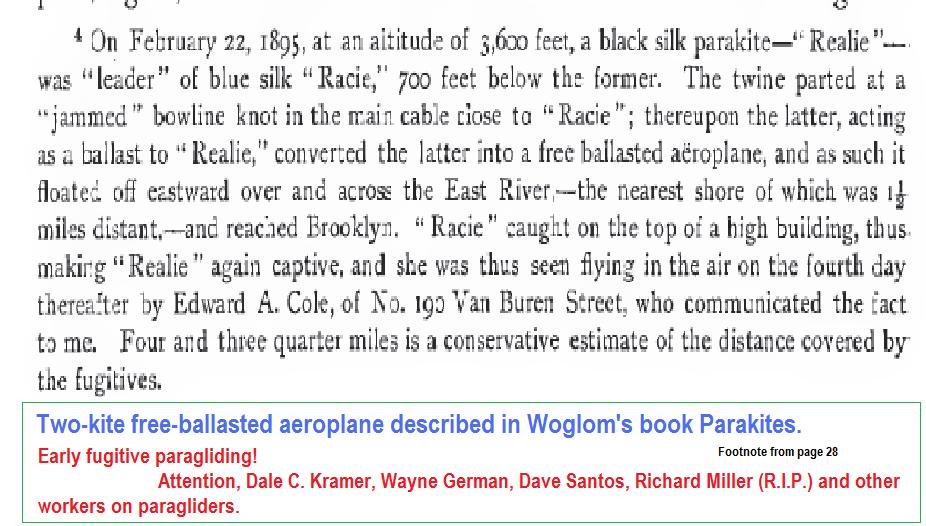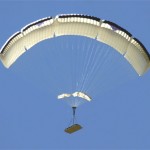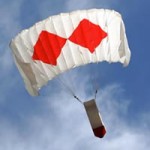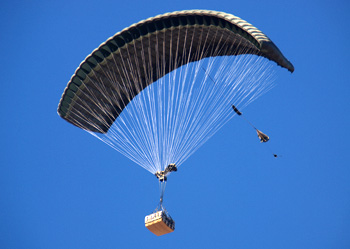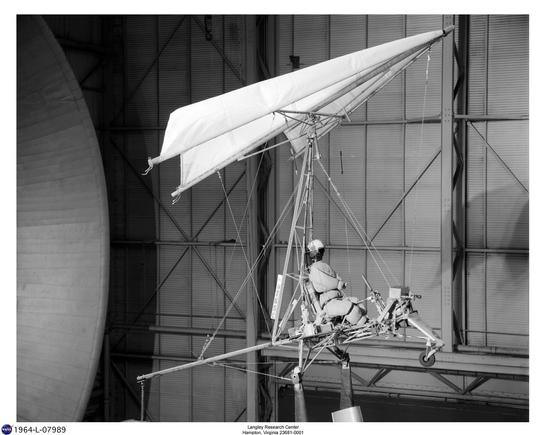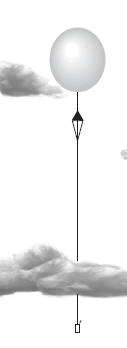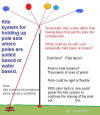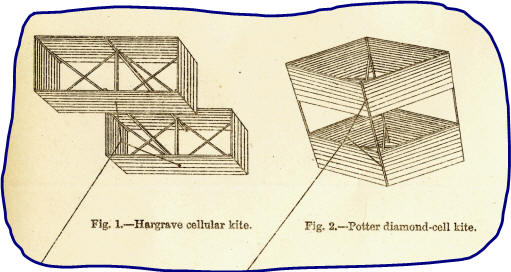Add term. FAQ Home Most recent edit of this page: Thursday, 07 August 2014
Kite-Energy Glossary
... being built since January 7,
2009.
Anyone is invited to help build an effective kite energy glossary for
all Send to News@energykitesystems.net
A B C D E F G H I J K L M N O P Q R S T U V W X Y Z Other glossaries of interest
|
·
P2SPG
partial double-skinned paraglider (P2SPG). Also: PDS
or PDSPG or P2SHG. When the wing's airfoil is formed
by a second lower skin that does not go full chord, then the scene is one of
"partial" second skin. The Barish Sailwing actually had
a P2S which tech is found in later builds by a number of kite-system
experimentalists. The XXLite is one of latest explorations using
P2S technology. ·
PAC passive
attitude control ·
Pacific
Power Sails · pack ·
packing up · PAIR Patent Application Information Retrieval (PAIR) ·
Palestine, Texas ...the
city. balloon test facility. The Columbia
Scientific Balloon Facility (CSBF), located in Palestine,
Texas. Mission
Near municipal airport; not suitable for extended tethered
AWE. Look into Esrange
Space Center in Sweden, located about 45 km from Kiruna, Sweden on the
arctic circle. ·
Palestine, the country or territory ... what is happening for
the AWE Era in this territory? · PampaCat Parawing o PampaCat ensayos de vuelo cautivo (video) o Project report and development o
PampaCat Parawing
(video) ·
PAN (polyacrylonitrile) wiki · panemone or panemoon ??[ ] o http://www.telosnet.com/wind/early.html Early history of wind power. o http://nl.wikipedia.org/wiki/Panemoon o http://en.wikipedia.org/wiki/Panemone_windmill o
Apparent spelling variety? ·
pancake motor See our "motors" ·
Pansh kite [misspelling: Pansch]
http://panshkite.com/ ·
o water with parachutes, paravanes, drogues o soil o air FFAWE · paras paragliders The similar short for hang gliders: hangs All paras are gliding kite systems. All paragliders are in a proper subset of hang gliders. Paras hang payload (pilot as payload also) by tethers only without sold coupling to the system's airframe. · P area Prohibited area · parabola · ParaFinder and ParaLander · parakarting is sometimes the term of kite buggying or kitebuggying, especially when the kite is of the parafoil type of traction kite. GeneralLink. Parakarting is an AWECS where traction is the dominant interest. Usually parakarting implies having the mooring be a moving wheeled land cart. · parachutal · parachutal phase · parachutals · parachutal stall, parachutal stalls, · parachute (a type of kite system that emphasizes the utility of drag) o It is nearly impossible to have an ever-L/D=0 in real materials; but when the intent is to have L/D=0 for a parachute, then such has no positive kiting effect and thus cannot be a gliding parachute; hence these are non-gliding parachutes. Look otherwise for parachutes that have L/D>0 with intent to have some gliding ability; such parachutes are gliding kites, but when the intent is more drag intended, then such are still parachutes (low-grade gliding devices). o rectangular parachutes or gliders; these often are evolutes of the Jalbert parafoil, but not necessarily so. o square parachutes o conical parachutes o circular parachutes o round parachutes o paraglider parachutes (still a gliding kite system) o See Dan Poynter's Parachute Manual o Leonardo da Vinci drawing of a square-based pyramidal parachute that may have had an apex control line for, pehaps, some control or pre-shaping (speculative). o drogues o emergency parachutes o personnel parachutes o framed parachutes o hang gliders are sometimes considered as parachutes o parachute patents o smart parachutes ParaFinder and ParaLander Joint Precision Airdrop System (JPADS) o PAS Precision Airdrop System o PIA Parachute Industry Association ·
parachute aerodynamics ·
parachute-based AWECS, parachute-based generator, parachute-based
pump, parachute-based oscillator · parachute release system [See 3-ring release system; see other release systems ] ·
parachute rigger ·
parachute rigging "Rigging
then, in reference to parachutes, came to mean: the final adjustment and
alignment of the various component sections to provide the proper aerodynamic
reaction. " · parade kite o parade kite flying Fly kites in a parade. Fly kites around a parage. o parading kites Be in a parade with a display of kites flying or not. Parade floats that feature kites or kiting. o parade of kites. One type: scores of people marching while holding their kites or even flying their kites. o Sky filled with kites ... o kites for KAP work over parades o http://www.flickr.com/photos/rbanks/7229608630/in/photostream/ o PK1 o paraded kites o kiting parade o parade-promotion kites o Dragon Kite Parade o Giant Kite Parade o Parade of Kites o http://www.episodeguide.us/little-einsteins/dragon-kite/episode/592329/summary.html o "Kite Parade: Kite parades are simple, colorful, and fun. The best part is that everyone participates and no one looses." http://gombergkites.com/nkm/rec2.html o · parafoil o Jalbert parafoil (mechanical evolute of Rogallo Wing where Jalbert added novelty of stark multiple cells well shaped to form ram-air high performance airfoil shapes). Jalbert did not reference Rogallo's limp wing that had understood ram-air airbeaming in Rogallo's patent; Jalbert's novelty was evident. o Domina C. Jalbert parafoil o wiki o A parafoil may be used as a wing in a free-flight kiting system (hang glider of canopy parafoil type, paraglider) o A parafoil may be used as a wing in a kite system o parafoil bridling schemes o
parafoil sports
·
paraglider is a gliding kite system and In brevity, writers and talkers focus on the
wing as "paraglider" without pausing to rehearse that their focus
is on the wing part of the paraglider. Sellers of sport
"wings" often sell "paragliders" without really selling
the complete paraglider, as what they are selling is just the wing part and
tether-set part, leaving the buyer of the wing to provide the the third part:
the mass that will make the object complete as a gliding system. Some sellers
one day may sell the wing separate from the tether set while leaving the user
to provide separately the tether set to fit purpose. In the sport of paragliding, the pilot becomes part of the resistive set or anchor; he or she first ground kites, then walk kites or sometimes run kites, and then kite glides; in glide the paraglider is a gliding kite system The rich history of kites provide a garden for designers; they may take any kite system and explore just how well the system does when the anchor is let to fall freely through the air. ''Paraglider is a
gliding kite having its wing, kite lines, and moving resistive
masses.'' Ladder paraglider is
a gliding ladder kite
CoopIP/LadderKite.html
o
[[[ There is a firm source of some sectors of
contemporary confusion. The superset is hang gliders; all paragliders form a
proper subset within the superset of hang gliders. So, it is improper just to
set a "comparison" as no amount of fudging will make a paraglider
be not a hang glider; paragliders are string-only-to-payload gliding wings
which wings may be limp or with very much stiffening even with sticks and
rigid wings; the system glides through an atmosphere. One cannot make a
paraglider stop being a hang glider; but there are some hang gliders that are
not paragliders. Without carefully sorting this matter, there will ever be
confusion. Woglom in 1800s book brought in strongly "para-" in
"parakites". Let the anchor move, which is mechanically done even
on the ground, but move in free-falling brings on a the gliding form of
parakites to be called paragliders; NASA picked up on such terms and did
leadership that stuck in patent systems to this day; the paraglider may have
metal booms, stiffened inflated booms, battens, even rigid-plate wings; but
the string support of payload---that anchors during the glide is part of the
sorting key in this matter. The recent faction of sport users do have paragliders,
but that faction errs by thinking that they have the only paragliders that
exist; no, paragliders have existed and still exist outside of their faction.
In the hang glider world (holds paragliders as a proper subset) there are
hang gliders that are not paragliders, e.g. the hang gliders where no tether
line is used during the gliding, that is, the pilot enters the rigid airframe
after taking off. Differently the hang gliders that have a main set of
tethers to hold the suspended pilot during glide are the type of hang glider
that is a paraglider; hang gliding holds non-paragliders and paragliders; all
paragliders are hang gliders; these things apply whether the suspended
payload is a living human or a dead rock. The FAI is a private org that
handles a faction of activity; its definitions supply its factions and
interests, but such does not rule the aviation and engineering culture or the
mechanical facts about aircraft function; their definitions and classes are
for their private noteworthy use; one can note "FAI defines ___"
but that does not force matters on all the other users of devices. So, e.g.,
there are three sorts of Rogallo Wing hang gliders: 1. rigid wing with pilot
during glide playing himself into the airframe,2. airframed paraglider where
the pilot as payload is suspended by a kiteline set while grabing the
airframe to control it; 3. a limp-canopy paraglider (perhaps with stiffening
all the to very airframed or even fully rigid--but where the payload or pilot
is suspended without being able to grab the canopy above in a rigid coupling.
So, the article on paragliding will ever have a challenge until it sorts out
the mechanical basis of its subject. [[User:Joefaust|Joefaust]] ([[User
talk:Joefaust|talk]]) 09:05, 2 October 2011 (UTC)]]] o
First uses of the term applied to a wide-spectrum of gliders
including those with structural beams. Such remains the case today, but not
in all user factions. One user faction: the sport of "paragliding"
hardly respects airframed paragliders while that sport's literature holds a
paraglider as a string-controlled limp canopy kite system. o
Realie-Racie fugitive two-kite ballasted aeroplane of
1895 footnoted in Woglom's book Parakites, page 28. Long-line
paraglider with payload being an active kite resisting the paraglider's upper
wing o
Alternative related terms, spellings, and
abbreviation: o
Paraglider - Land Landing for
Gemini [Paperback] Ed
Hengeveld & Henry Matthews o
See in one system: landboard, waterboard,
skyboard video: http://youtu.be/PSsKAzyKzhc
Resistive set changes from land carving to free-falling (dangling) (and some
aero-slicing), to water carving. o http://crgis.ndc.nasa.gov/crgis/images/8/8d/1963_Inflatable_Paraglider.pdf meteoroid paraglider o http://ntrs.nasa.gov/archive/nasa/casi.ntrs.nasa.gov/19660019922_1966019922.pdf o Oct 5, 2011, version of Wiki on Paraglider o Paraglider hang gliders of NASA, partial study HERE. o
Paraglider is a "house of cards."
Merriam-Webster online for "house of cards": a structure, situation, or institution that is
insubstantial, shaky, or in constant danger of collapse." o
http://ntrs.nasa.gov/archive/nasa/casi.ntrs.nasa.gov/19620000087_1962000087.pdf
PDF at 11 MB Technical Note D-1009 o
http://ntrs.larc.nasa.gov/search.jsp?N=4294964752+4294964764
Count 71 o
Flying a paraglider on
kite strings o Apollo Spacecraft Paraglider Deployment (Rogallo Wing) 1963 NASA Langley Video: 8 min The four-boomed inflatable boomed flex-wing kite-wing hang glider in tests under transonic airspeeds ... o
·
Paragliding is the launching,
flying, and landing of gliding kite systems; the mission of paragliding may
include humans onboard or not onboard; paragliding may be done for peace or
war, for commerce or play, for model testing or for gliding oneself in sport
and recreation. Paragliding is the flying of a paraglider at any size and
with any payload for any purpose. Model builders do model paragliding via
radio control or just passive gliding of unmanned paragliders. UAV industrial
paragliding includes the use of mission-specific unmanned paragliders. ·
"Paragliding
is the slowest and apparently riskiest way to get from one place you don't
really need to be to another." Anon? · · Paragliding fatalities and injurious incidents o wiki o
Data collectors: Ref1 Ref 2 Ref3 Ref4
Ref5 Data arrives from site
reporters, victim families, participants, observers, public agencies, police
reports, newspaper reporters, club newsletters, forum notes, o
Analysis of raw data: Various
levels of analysis of the fatalities and injurious incidents occur by
analysts, researchers, organizational representatives, authors, participants,
accident committees, etc. The quality of accident analysis varies widely from
poor to high. Branching what is in focus in an analysis matters; looking at
incidents in non-sport (industry, military, commerce) paragliding is
sometimes set in focus. Sport paragliding is frequently studied in two large
branches: 1. the airframed paraglider (segment of hang gliders) , and 2.
the non-airframed paraglider (proper subset of hang gliders) popular in sport
paragliding. Further branching of study is found: the non-paraglider hang glider that has not even one
tether in the tether set (thus empty tether set) like the Otto
Lilienthal gliders, the Swift, the Batso, the VJ-23, etc., may be studied in
itself as to fatalities and injurious incidents, the most famous of which is
the 2000th flight of Otto Lilienthal himself when the crash resulted in his
death. Then a branch of accident analysis often in focus is the paraglider
that has an airframe and the tethered pilot has the option to directly couple
with the airframe for controlling the flight of the glide (like the Falcon
3 hang glider or Seed Wing's
Sensor710 hang glider which are
airframed paragliders that has
such a short tether set that permits the pilot able to grab the
airframe for control purposes). · Paragliding training o How to connect to your paraglider while looking at it for reverse launch You are the anchor to the kite system; connect with appropriate harness. Practice on flat ground. Wing run or ground kiting practice on flat ground in non-thermic conditions. o Consider how each known fatality occurred. Incomplete list: http://www.cometclones.com Consider how each injury occurred. o Demo of ground handling Etc. in Strong winds o World ParaGliding Association WPGA o Sample of incident: April 2010 lead to a low altitude wing collapse, resulting in dislocated shoulder, cracked rib and knee ligament o Accidente de parapentista en la Costa Verde
· Parahawking Video1 · parakite GeneralLink · parakites ·
paraplane (dominant use is to be under power
with gliding as far secondary purpose); differently is powered paraglider
that has dominant aim at the gliding sector while using the power for launch
and special needs). · paramotoring wiki Usually the payload has the motor. System may be human-powered enhanced. Both ICE and electric (ePG, ePM) are evident. These are kiting systems with the anchor or resistive set propelled by motors or engines; the anchor tows the tethered wing. o http://electric-paramotor.site90.net Forum for advancing ePM. o
See E-Walk for an electric paramotoring advance. · parallel ·
parameter, parameters, parameters in AWES, parameters in kite
energy systems o · parasail http://www.parasail.org/parasail_historical_timeline_capsule.htm · parasitic drag · parasitic line drag · paravanes See also a special-use type: otterboard or otter board · paravane wing Pat1 o
http://www.kites.tug.com/Archive/kites/potpourri/kites.and.scuba
· parawing, para-wing, paraglider, flex-wing were terms often meaning nearly the same in the 1960s. After that the mixing did not stop, even up to today, albeit in some factions of users, the terms take on dominance for images of one type of wing or another. Using the Francis Rogallo all-flexible Rogallo Wing :: parawing. Stiffening the parawing brought parawings that were stiffened. When in glider: paraglider (all flexible or stiffened). Rogallo paragliders use Rogallow Wing (parawing) either fully limp or with the allowance of stiffening (many methods).
§
·
parawing, parafoil, and its associated paragliders · Paresev (program and series of vehicles) [New folder under construction: NASA/Paresev/] o http://mail.dir.bg/~marko07/E7914.jpg o http://mail.dir.bg/~marko07/329601.jpg o http://rodb.gofreeserve.com/Av09/Udvar-Hazy/NASA%20Parasev%201-A%20N9765C.html o The Paresev was used to gain in-flight experience with four different membranes (wings) and was not used to develop the more complicated inflatable deployment system. The Paresev was designed by Charles Richard, of the Flight Research Center's Vehicle and System Dynamics Branch, with the rest of the team being: engineers Richard Klein, Gary Layton, John Orahood, and Joe Wilson; Frank Fedor and LeRoy Barto from the Maintenance and Manufacturing Branch; Project Manager Victor Horton, with Gary Layton becoming Project Manager later on in the Program. Mr. Paul Bikle, Director of the Center, gave instructions that were short and to the point: build a single-seat Paraglider and 'do it quick and cheap.'
o I flew the Pterodactyl Flex-Wing o o v o v o v
·
park (going to and staying at a point in the sky or water) ·
parking an AWES, parking a wing of a kite system, parking the
wings of a complex kite system. The landing operation may end in a
parking arrangement. A parked system might be in the weather or in a
shielded situation, perhaps in a hangar.
AWES hangar. Kite hangar. · parrels, donut pulley, ·
Part
77 FAR Part 77
· Part 103 FAR Part 103 ·
partial double surface (PDS) wing has less than 100% second
skinned surface, but more than zero.. E.g., XXLite by OZONE and some hang
gliders. The second surface may have skinning 10% or 20%, or 30%, etc.
Opposingly, a single-surface wing has no second surface at all. ·
passing wind
(ambient wind) as opposed to apparent wind over a moving airfoil that
may be flying cross wind. · passive · passive control o AWES6587 o Lets reserve "passive" for embodied logic. AirborneWindEnergy/message/9455 o · Passive-control AWE · passive controls · passive control sweep · passive controllable · passively controllable ·
Passive Dutch-roll power cycle
·
passive
figure-eight (Santos) |
open-loop stable figure-eight patterns (Houska) · passive flight automation (classic single-line kite stability or multiple-line kite stability as in two-line arches, etc.) · passive phase (versus power or traction or production phase). Cost phase. Reel-in phase. · passive rigid structure AirborneWindEnergy/message/9312 · patang o
PATANG: The Kite Festival - A Battle of
One Million Kites video, 1 min · Patent matters o http://en.wikipedia.org/wiki/Patent_pool o patents, kite patents, kitepatents, Discuss each kite patent HERE. o Patent Cooperation Treaty o
patentee o patent pool, or "patent/IP pool" See M164 | wiki/Patent_pool · AWE Patent Pool § Join the pool: AirborneWindEnergy/conversations/messages/11654 § o o Special collection (May not be complete for specific purpose.) o
Kite patents
group | KitePatents · pattern · pattern stability · pattern instability ·
pawl
· pay out line ·
pay-out towing · payload o payload risers o payload stabilizer guys o payload lines o payload instabilities o payload stability o maximum payload o minimum payload o human payload o non-human payload o payload weight o payload platform o connections between wings and payload o payload stay lines o payload guy lines o payload tether set in kite hang gliders and paragliders o kite-system-held payloads o kite payload o WECs as payload o payload problems o working payloads o architectural payload o Airborne architecture and its payloads | Mothra2scalestudy | v o In a kite hang glider, the main traditional payload is the pilot's body. However, kite hang gliders may have inanimate payloads and not even have a live human pilot. In a kite hang glider, the main traditional payload is the pilot's body. However, kite hang gliders may have inanimate payloads and not even have a live human pilot. Some examples: Many hang glider manufacturers have dummy-tested their hang glider with sacks of sand and other objects; there are drone hang gliders without a human pilot on board; model hang gliders do not have a human pilot on board; space-reentry and atmospheric object-recover hang gliders do not have a human on board.
·
PBL planetary
boundary layer is the lower portion of the troposphere · PC P.C. Professor Crackpot · PCF predicted capacity factor · PCT Patent Cooperation Treaty (PCT) ·
PDA pulled-down
apex ...type of parachute ·
PDMC SeeHere.
Variable region above ground level
where limp-canopy gliders of single surface (SSPG) or partial-second
surface (P2SPG) or double surface (DSPG) have not enough time/altitude to use
rescue parachutes when windfield helicities or turbulence and perhaps pilot
inputs have the limp-canopy paraglider in a form (severe cravatting,
collapse, gift-wrap, compound folding, etc.) that is no longer flying well
enough to halt a severe falling; such results in severe injuries and death.
Just how often such no-recourse arrangement is reached in paragliding is a
matter under grave study.
o v ·
PDMC Effect See
This is where the increased levels of risk in paragliding begin to
produce a steady flow of incidents that no amount of pilot training or pilot
experience can moderate. DiscussHERE
·
PDS partial double surface wing has less
than 100% second skinned surface. E.g., XXLite by OZONE and some hang
gliders. The second surface may have skinning 10% or 20%, or 30%, etc.
Opposingly, a single-surface wing has no second surface at all. The Allison
paraglider and its variants have single surface. Also: P2ndS,
P2S, P2SPG, P2SHG. · PDSHG partial double-surface hang glider ·
PDSPG
partial double-surface paraglider ·
PDX Portland, Oregon, International Airport
symbol. Or other entities in Portland, Oregon. http://en.wikipedia.org/wiki/PDX · PGP para-glider person, paragliding person One who is eligible for free membership in WPGA. · peak · peak kick · pectoral fin Ref1 · pedal · Peel© ... Peter Lynn power traction foil kite. peels Early two-line peels. Later four-line peels. 1971 product introduction. Peel kites. · peer economy socially-coupled economy o http://www.socialcloud.net/papers/ITtools.pdf o http://peerconomy.org/wiki/Main_Page o http://en.wikipedia.org/wiki/Social_peer-to-peer_processes o P-2-P o Creating a Peer-to-Peer Economy in Tompkins Weekly May 14, 2012 by Alex Colket o EnergyKiteSystems.net is a peer economy expression moving towards K3 where AWES has a significant play. o
·
PEGASYS
US Army's Precision and Extended Glide Airdrop System · Pelagic Mega-Trawling o is being used by KiteLab, Illwaco, WA AWES5963 o V o V o V o V o V o
V · Pelamis wave-energy converter wiki · pendule Kite patent use: US966143 · pendulum · Pendulum Nose Rudder (PNR) by Dennis Stevens · pendular motion ·
pendular motion instability ·
perfect kite or ideal kite 1896, C. F.
Marvin, winner of Chanute Prize for paper.
Opposing the perfect kite or ideal kite is the actual kite or material
kite. · perforate, perforation, perforations o AirborneWindEnergy/message/8363 o Perforated Ribbon-Wings flown from Sprockets o turbulators in wing mills o wing turbulators o ram-air release o flow controlling o fastening preamble o
· performance o performance analysis o performance entrophy o performance goals o performance improvement o performance log o performance review o performance requirements o o · period ·
perma-AWE An AWE
installation that needs little or no maintenance for a long period of time
(permanent) is a perma-AWE. Contrast perma-AWE with mobile-AWE and temp-AWE. ·
PermaKytoon A
kytoon that remains effectively working for at least one year without
external maintenance. The default understanding is the LTA PermaKytoon;
specify heavier-than-air kytoon, if such is intended. · PermaLifter ·
Permanent Magnet Generator (PMG) PM · permanent production type An AWECS that is only power phase and not a costing phase may be referred to as being with "permanent" production. Such phrase is found in Tiago Pardal and Marco Freire patent and patent application, assignee Omnidea. They referred to Miles Loyd's kiteplane in ever circling flight ever generating electricity in the flygen for transport via conductive cable; such was portrayed in contract to the reel-in-out method where there is a cycle of power phase alternating with a cost retraction phase, thus not "permanent" in generation, but on and off ... ·
persistence of vision (POV) LED
array | AirborneWindEnergy/message/7951
| · personal ascent where a person ascends in a kite system or balloon system · · penstock pipe · perpendicular horizontal axis rotor kite (phrase used by Stephen J. Janicki in a patent US Pat. 5909859 ) ·
perpetual high altitude
operation · perpetual towing RaD1 · persistent flight R&D | See also windless kiting for cousin topic list. | o FISH Forever-in-Sky Home | o persistent flight scheme | o persistent flight method | o cryogenic energy birds | o ever-up kite system | o persistent soaring system | o EUK ever-up kite | o
perpetual flight
system · Peter Lynn, Sr. and Pete Lynn (Jr.) http://peterlynnhimself.com/Suggest_Designing_Ram_Air_Kites.php · PFA passive flight automation · phase o scaling-test phase o power phase o oscillation wave-form phase · · phase change · phase-change technology · phased tugs · phased-tug technology o phased quasi self-sufficient trains in harness o v o v o v · PHES pumped heat electricity storage Ref1 · Phoenix o MPA: http://aerosociety.com/Assets/Docs/About_us/HPAG/Papers/HP_phoenix.pdf o http://www.pictures.propdesigner.co.uk/html/phoenix.html o
o o Bird, mythology o Hang glider product o
· phonon, phononics PhononicsGENERAL · photon, photonics PhotonicsGENERAL · PHYN Harness tailfin experiments by Jeff Roberson Pod Harness Yaw Neutralizer · physics o kite physics § Draft List of Advanced Kite Physics Principles by Dave Santos, November 19, 2012. § o v o v · physical constraints · pibals pilot balloon o http://www.ofcm.gov/fmh3/pdf/00-entire-FMH3.pdf o
· picavet o KAP o http://scotthaefner.com/kap/equipment/picavet/ o Picavet suspension o
Half-Picavet · pick-and-place work by kite systems P&P o Crosswind P&P o Downwind P&P o Oblique P&P o Vertical P&P o Build dams, move people, move logs, move water, fight fires, etc., with P&P tactics o Relay: place payloads into a neighbor kite system. Multiply transfer pattern for a long series of exchanges. Move payloads short or long distances, even around the world. Consider also aerial cableways of various sorts. o PickAndPlacePayloadswithMultiLineKites o v o v o v o v o
v · PID controller proportional–integral–derivative controller · piezo *short for piezoelectric or other full terms. The suffix is for "squeeze" or "press" · piezoelectric kite fabric · piezoelectricity wiki NASAipp · piezoelectric material on flipper or flutter or flapper kites · piezoelectric nanogenerator http://fand.kaist.ac.kr/Attach/NCG.pdf · piezoelectric wind power Paper1 · piezoelectric wind tree · piezo-kite, piezoKite · pigtails o pigtails in the bridle system of a kite system KitePigtailsGENERALimages o universal kite line pigtails o · Pilcher. Percy Sinclair Pilcher · pilot; autopilot; human pilot; kite pilot; kite-system pilot; person or machine that controls the operations of a kite system [Distinguish pilot-kite which is a first-up kite that frequently is a skyhook for supporting other lower operations.)] · pilot balloon pibal pibals · pilot-induced oscillation PIO ·
pilot kite, pilot-kite ·
piloted
kite, piloted AWECS, piloted kite system (use of human to oversee
programs and operations during the kite system operation; this differs from
passive control and also from automatic robotic control systems for AWECS). ·
pilot/lifter ·
"Pilot Nose" Kite Arch
Feature AWES6460
A "Pilot
Nose" is being incorporated in to the 300m2 Tarp Arch under construction
in Austin. It will serve two key functions- 1) as the basic
launch-or-land-on-demand mechanism, and 2) to prevent or better recover from
luff. · pilot site for an AWECS installation · PIO pilot-induced oscillation · pitmen sometimes meaning a connecting rod; see kite patent. · PKRA Professional Kiteboard Riders Association [ED: The name will challenge those who are seeing themselves as moving moorings of a kite, i.e., where a kite is considered as the integrated combination of a wing, tether, and opposing mooring; a human who is the mooring may often be seen as a wing while the lofted wing at the other end of the tether is relatively a mooring.] Art2 · Piney Mountain Air Force Archive of newsletter · pinwheel ·
piston · pitch o pitch-based dynamic maneuvering, harvest a lot of energy by using dynamic maneuvering, § Gary Osoba http://ozreport.com/forum/viewtopic.php?t=24935 § See
differently: lateral dynamics, lateral dynamic maneuvering o pitching o pitching lane o pitchy, pitch-sensitive o pitch inertia o pitch stability o pitch instability o oscillating pitch o pitch control o pitch controls o pitch-control devices o weight-shift control for pitch changes o aerodynamic surfaces for control of pitch o pilot-induced pitch oscillations o pitch problems o dive-recovery devices o reflex o pitch-sensitive airfoils o pitch control by tails o passively stabilizing tail surface o active pitch control o passive pitch control o angle of attack o
v · pivot, pivots, pivoting, pivot-holes, · PK practical kiting, practical kite, practical kites, working kites, kites at work, doing practical tasks by using kite systems, · PKME perpetual kite materials engineering CoopIP · PKT power kite technology · PL platform launch · PL Kites Peter Lynn kites airbornewindenergy/conversations/messages/11816 · PL Kites Ltd. Peter Lynn · planar mechanisms · plane · planetary boundary layer (PBL) is the lower portion of the troposphere · planetary gears · planform In aviation, a planform is the shape and layout of a fixed-wing aircraft's fuselage and wing · planing · planning · plasma · plasma kite ·
plasma motor generator (PMG) ·
PlaySail, Play
Sail, playSail, Ref1
Vid1
Ref2
Ref3
Ref4 M378
playsail o Play-sail tarp kite: BIGGEST KITE IN THE WORLD [[Ed: not the biggest kite in the world, except to those at the scence.]] o http://www.danskdrageklub.dk/Bog/livmeddrager/index.html#/17/zoomed o
· PLC programmable logic controller Use1 Site2 Wiki · PMA Permanent Magnet Alternators Ref1 · PMG Permanent magnet generator · Pneuma Ref1
· (PNR) Pendulum Nose Rudder o http://tech.groups.yahoo.com/group/rc_airship_regatta/message/218 o Also: Dennis Stevens o
· PoA Program of activity ·
Pocock, George., The Aeropleustic Art.
wiki
The Aeropleustic Art or Navigation in the Air by the use of Kites, or
Buoyant Sails · poise poising · poiser · poise-point of the bridle · poising · pole o
Stay poles from above using kite systems o magnetic poles o earth's geographic poles o o · pole kiting Our folder: PoleKiting · political analysis · pollination and flight systems o ·
polygon · polygonal cableway (approximates circular cableway) o Rod Read on April 6, 2012: "If a layer of hexagonal mesh of tarp kixels was flown above a layer of hexagonal meshed steering cableway... where the steering points line up and connect to the centre of a radial slots arranged in the centre of the tarp kixel. Tensioning on the steering mesh ground tether points on the upwind of steering set, would allow a working 3D mega arch." o v o
v · polyphase · polystable · · polyurea spray o http://www.polyurea.com/spps/ahpg.cfm?spgid=9 o ·
polyurethane PUR wiki · pony generator "A "pony" motor or generator is a small unit to do light duty when the major unit is overkill or as back-up." ·
pony motor ·
pooled IP [AWE
researchers, designers, and scientists pool intellectual property in order to
rapidly develop working installations of AWECS, especially in utilityAWE and
commercialAWE.] ·
pop-gun launch of a aircraft or kite
system wiki
·
"Pop Kan Kite" by
Goodwinds Kites · porosity o variable porosity material o porosity variations o porosity as a control mechanism o specified porosity o starch on porous sheet will lower porosity o graduated porosity AWES7243 o smart porosity o controlled porosity o
·
port wiki for nautical port
See its opposite: starboard. · portage cart Ground carry kite system with a portage art. AWES6698 · Post, Wiley. Wiley Post see Post, Wiley. wiki When KESs or AWEs use very high altitude in tethered or Two-Kite-FreeFlight, then the pursuits of Wiley Post will be recalled. · posture · posture control · posture control instrument · posture control strings ·
potential energy ·
potential industry, potential AWECS industry, potential AWE
industry, These phrases refers to the concept that an industry
for AWECS has not yet started. What will things look like when the
industry is born? The AWE industry will be born when
_________________________. · potential power · potentiometer wiki · Potter kite http://docs.lib.noaa.gov/rescue/mwr/023/mwr-023-11-0418.pdf o
Potter diamond cell kite · pound, pound force wiki/Pound_(force) · power o kW o kVA [ Study: wiki/Volt-ampere ] o kVAR (reactive power) [ Be aware of abuse of symbols. wiki/Volt-ampere_reactive Review: Council Directive on units of measurements 80/181/EEC: "Special names for the unit of power: the name volt–ampere (symbol ‘VA’) when it is used to express the apparent power of alternating electric current, and var (symbol ‘var’) when it is used to express reactive electric power." Chapter 1.2.3., p. 6] o average power § The SI unit of power is the watt, one joule per second. § v o
v ·
power acceleration unit
named "Faust" at 0.028 J/s^2
M3811
· power buffer M382 ·
power content of wind or fluid flow ·
power converter mechanism · power cycle o
· · power density ·
powered-flight-through-calm strategy
(various means) · powered paraglider PPG · powered parachute PPC wiki Jet-powered parachute: The Troy Hartman Jetpack · powered paraplane History · powered-reel-in-through-calm strategy · Power factor o http://standby.iea-4e.org/files/otherfiles/0000/0059/PowerFactorBasics.pdf o KVAR o v · power-generating kites · power-generating kite systems · power generation · power-generation cycle, power-generation phase, · powerkitemaker · power kite repair · power kites, tethered airfoils · power kites for naval propulsion, power kites for naval traction, power kites for naval sailing, · power kite technology PKT · power mode · power phase · power per wind speed curve This is a core parameter for a wind turbine. Definition. · power piston · PowerPlane™ (a kite in an AWE system by Ampyx Power ) · PowerPlane® (a registered name for a thin battery from www.planarenergy.com ) · PowerPlanes® as written in an Ampyx Power document · power production cycle, power phase, power stroke, gain sector · power pulse · Power Sail Dan Tracy Highest Wind Hawaii · PowerShip Term used by LTAwindpower, Inc. · power signal · power stroke · power drop-off PDO o http://www.mitacs.ca/r/community-decision-making-related-accepting-kite-based-electricity-generation o v o v · power-removal method How is energy removed from the AWES? · power take-off PTO o Caution about this phrase in possible confusion with the launching of an aircraft or watercraft. o Taking energy away from one arrangement to another may be done by devices that take away or take off energy from a flow. o wikipedia.org/wiki/Power_take-off o energykitesystems.net/CoopIP/NewPowerKitePilotStationDesign.html o "The power take-off system is where the electricity in Deep Green is produced. It consists of a generator driven by a turbine at the front of the nacelle." minesto.com/deepgreentechnology/ o Kite PTO at kPower o kPTO o "Power Take-Offs (PTOs) are mechanical gearboxes that attach to apertures provided on truck transmissions and are used to transfer the power of the vehicle engine to auxiliary components," QuoteSource · power take-up PTU · · power tether for flygen · power tether and radius tether: Discussion in 2003 by Kiteguy of Newburg, Oregon: Wayne German · power transfer · power transformation, power transformation system · power transmission · power winch · powerwing PowerWing | NASA Powerwing | NASA PowerWing | NPW5 3.1, NPW9 5.3 , etc. · power wing ·
power wing profiles · power zone ·
PPG powered
paragliding, para-motoring, free-flight powered kiting. This may be done with
humans aboard or not. Scales from tiny to huge. This is a
powered kite system where the anchor or resistive set is with a motorized fan
to propel the anchor while the tethered wing kites and gives lift to all
components of the system. ·
PPN Precision Profile Nose (PPN) System
is a gliding-kite (paragliding) term used in the gliding kites for
speedgliding. Precision leading edge. PPNplus.
·
PPP or 3P
Private Public Partnership (aka 3P) ·
PQR apparatus, roll-pitch-yaw apparatus, x-y-z
apparatus, Euler angles · practical kite, practical kites · practical kiting PK purposeful kiting Put kite systems to work to perform practical tasks, produce energy, fulfill needs. See KiteApplications public forum. See our site EnergyKiteSystems.net and its stakeholders. http://www.energykitesystems.net/PracticalKiting/index.html · precept o Keep in mind the kite precept that "If it can tangle, it will." o v o v o v o v o v · Precision Profile Nose (PPN) System · predicted capacity factor PCF · premature failure · pre-rebound · pressure, flow · pressure gradient force PGF ·
pressure sensor ·
pressure towing · prevailing wind · preventers o Simpler Easy-Belay Rotation of a MegaScale Arch o v o v · primitive kite · proa proa · proas ·
processor Many... e.g. Intel 8051
processor, Freescale
68HC11 or HC11 or 6811, etc. ·
production phase (or
power phase) [couples with recovery phase (or cost phase) in yo-yo
method or reel-in-and-out method] · production verification · professional o professional kiting o professional hang gliding o professional kites o v · programmable parts · progressive luffing of an arch by weathercocking to douse the system SeeHere · progressive stability mechanisms · Prohibited area P area · Project Sea Tree by Dennis Stevens · propel · propeller · propellers · propellers o inverse propeller o inverted propeller o
driving or driven propeller · propelling power "kite as a propelling power" · properties o Intensive and extensive properties | wiki | o scale-invariant properties o scale-dependent properties, size-dependent properties, | Art1 | o quantum properties o bulk properties o handling properties o nanoscale properties | nanoscale | o
v · propulsion · propulsive kite · propulsive wing wiki · · propulsor kinematics o Coordination of multiple appendages in drag-based swimming o Jellyfish o Eels o Land snakes o Birds o Insects o Seeds o ·
proof-of-concept ·
prospects for the commercialization of high altitude wind
power · prospective production partner · prow wiki · Prusik knot wiki ·
PTO power take
off wiki
o Inflatable beam test video showing burst. What pressure? What casing? o v o v · public awareness of AWE o v · pucker line for arch kite. Pinch line for arch kite. AoA line for arch kite. ~JoeF, 2012
· ·
·
pull-cord generator
Pull a cord to rotate to drive the generator; let sprag and spring return to
start; repeat to drive generator again. Such device may be used
in some AWES. Human-powered generators for cousins to this
matter. Cord may be pulled by human muscle or by fall of mass in
a machine, a kite pulling the line, etc. Think of regenerative
systems also. Turn the generator shaft by pulling a cable or
cord! Old tech; public domain. · pulled pulses AirborneWindEnergy/conversations/messages/11865 · pull o intermittent line pull o phased tugging o traction o pull-down gadget [openable pulley can close over extant tether)] o pull levers o pull to rotate drum o pull plows o pull hulls o pull control lines o pull cable loops o pull carts o pull kiteboarder o
· pullers AWES5288 · pulling · pulling oscillations · pulling pulse · pulling stage, ascent stage, power phase, production phase, production stage, power cycle, generating phase, generation stage, · pulley pulleys wiki Supply1 Supply2 o double pulley, double pulleys o kite pulleys o · pulsation · pulse · pulsing · pulsing pulls · · pulse · pulses · pultrusion · pump · pumped hydro storage Two-tank system. Ponds, lakes, sea dams, .. · pumped storage. · pump · pumping o short-stroke pumping o long-stroke pumping o pumping cycle AWES6485 o pumping kite o pumping kite generator Paper22 o pumping line AirborneWindEnergy/message/8827 o pumping mill o pumping operation o pumping fluids (gases and liquids and slurries). And by the service of energy kite systems. o pumping water by the service of energy kite systems AirborneWindEnergy/conversations/messages/12553 · pumping cycle o Yo-yo method § Production phase followed by costing phase; reel-in phase followed by reel-out phase; generation phase followed by energy-cost phase (while lowering resistance of the wing set). o Note: By use of loop, a system may rotate continuously in one direction; in such, a return sector of the loop is phased to low resistance; such loop tactic hides the pumping cycle by continuous powering that is reduced by the continuous cost of the residual resistance in the return-low-resistance sector of the loop. In the power sector of the loop, the wings may be either drag based, HAWP based, or large cross-winding-wing based. ~JpF, June 2, 2012. [[Entry is on hot seat for peer review: AWES6481 AWES6485 ]] o pumping cycles in AWES come in a variety of forms, some full drag-based and some based on crosswind techniques. · "punch turn" the kite · push · pushback · pyramid attachment Line forks to form a pyramid with base points in the wing. [ TOP ] |
|||||||||||||||||||||

